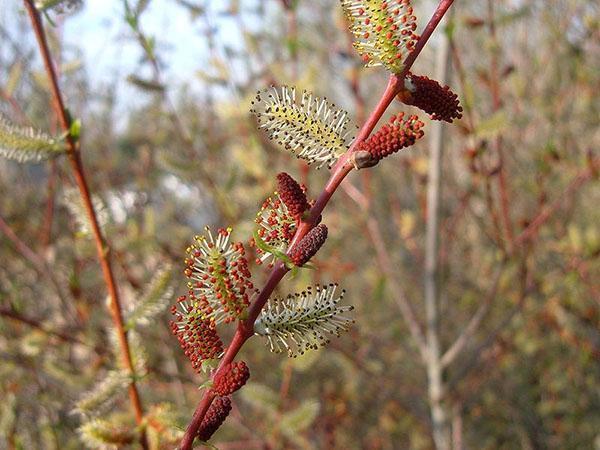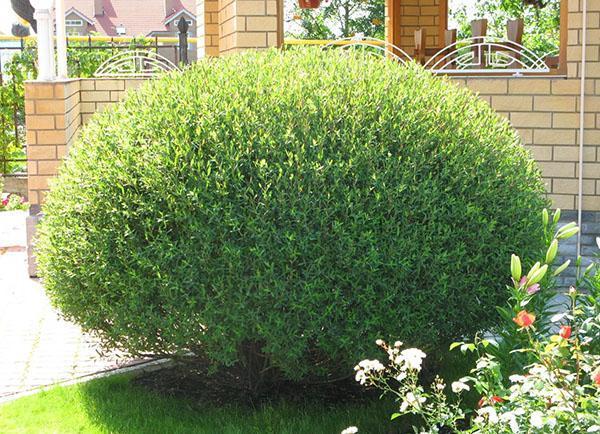Miracle with red branches - purple willow
 Purple willow is a shrub, sometimes a low tree, reaching a height of 2-6 m, depending on the species. The distribution area covers China, Crimea, Mongolia, the Caucasus, the plains of Western Siberia, North Africa, Central Asia, and Western. Europe. Her favorite places are wet areas of valleys, stream and river beds, sand and pebble deposits.
Purple willow is a shrub, sometimes a low tree, reaching a height of 2-6 m, depending on the species. The distribution area covers China, Crimea, Mongolia, the Caucasus, the plains of Western Siberia, North Africa, Central Asia, and Western. Europe. Her favorite places are wet areas of valleys, stream and river beds, sand and pebble deposits.
Distinctive features of the plant are thin and very long branches, painted in colors from brown to dark olive. Shoots are "naked", mostly covered with a bluish bloom. The inner part of the bark adjacent to the wood is colored lemon yellow. It tastes bitter.
The foliage is located on the branches opposite, alternately. Each leaf has a short-pointed narrow-obovate shape, gray-green or pale bluish-gray color and reaches a length and width of 3-13 / 0.8-1.5 cm, respectively.

Care
 When choosing a landing site, pay attention to light areas, for example, light shade or under the sun. Other areas are unfavorable for the decorativeness of the plant: it will be less voluminous and not bright.
When choosing a landing site, pay attention to light areas, for example, light shade or under the sun. Other areas are unfavorable for the decorativeness of the plant: it will be less voluminous and not bright.
In terms of soil, willow grows in all lands, but has a preference for fertile and neutral lands. In the case of planting on clay and heavy soil, do not forget about good drainage from sand and stones.
Planting seedlings does not create problems for either avid gardeners or beginners. To do this, you need to dig a hole with a diameter slightly larger than the roots. Next, ½ a bucket of water is poured into the formed hole, the seedling is lowered and covered with fertile soil mixed with compost, peat or sand. The soil around the future tree is lightly crushed, and then watered again.
In the future, you will need to observe regular watering. Moreover, in addition to root watering, the plant should arrange a "shower" from a hose in the early morning or in the evening after sunset.
The willow does not require any special “nutritional” requirements. In spring, 60-80 g should be added nitroammophos per bush. This will help build green mass.
It is necessary to loosen the soil around the plant. For young willows, the depth of the process is 20-30 cm, for adults no more than 10 cm, otherwise the roots can be damaged.
With the onset of spring, prophylaxis against diseases should be carried out (for example, powdery mildew, black spot) and pests (such as willow leaf roll, flower fly,) using Bordeaux liquid, fungicides and insecticides.
Varieties
Among the varieties of purple willow, two varieties are very popular: Pendula and Nana.
Purple willow Pendula
 The tree of this variety is popular due to its graceful weeping crown, painted in light green color. Moreover, flexible branches are painted in a purple hue. The height of the plant depends on how long the graft was.
The tree of this variety is popular due to its graceful weeping crown, painted in light green color. Moreover, flexible branches are painted in a purple hue. The height of the plant depends on how long the graft was.
During flowering, earrings with reddish-purple anthers are produced.
Willow loves light and has a fairly high winter hardiness. It is completely undemanding to the soil and can adapt to almost anyone. But the favorite is fertilized and moist. The variety is also attractive because it can perfectly tolerate both drought and flooding.For proper crown growth, the willow should be pruned annually.
Purple willow is often used in the landscape due to its good development of roots, which are able to strengthen the soil in the place of growth.
The plant is propagated by grafting to boles.
When planting seedlings, the distance between two specimens should be at least 1.5 m so that the crowns do not interfere with each other upon reaching adulthood.
Purple willow Nana description
 This is the most popular variety of purple willow. The name "stuck" due to the reddish shade of the bark, foliage and unusual color of flowers during the flowering period. The plant is not tall, the maximum height is 1.5 m with a crown diameter of 2 m. The shape of the latter is semicircular. Numerous thin shoots are covered with gray-green foliage.
This is the most popular variety of purple willow. The name "stuck" due to the reddish shade of the bark, foliage and unusual color of flowers during the flowering period. The plant is not tall, the maximum height is 1.5 m with a crown diameter of 2 m. The shape of the latter is semicircular. Numerous thin shoots are covered with gray-green foliage.
The plant is remarkable for its photophilousness, and excellent winter hardiness. As far as soil is concerned, willow is not capricious and can adapt to any soil. Nevertheless, he prefers moist places most of all. Also, the plant is able to tolerate slight moisture or drought.
The flowering of the plant, like that of the purple willow Pendula, begins in March-April, simultaneously with the dissolution of the foliage. The crown has a decorative value.
To form a beautiful shape, the plant should be planted in a bright place. Otherwise, the deficiency will provoke the stretching of the branches upward, which will adversely affect the crown.
The variety perfectly withstands pruning, which is preferable to carry out with the arrival of spring.
Willow purple Nana in landscape design
 Due to its "ability" to hold the soil together, willow is widely used to strengthen soils along the banks of water bodies. Due to the excellent tolerance of pruning, it is used in the design of garden compositions located in flooded areas and places with high humidity. Also, the shrub is planted to create geometric shapes in gardens.
Due to its "ability" to hold the soil together, willow is widely used to strengthen soils along the banks of water bodies. Due to the excellent tolerance of pruning, it is used in the design of garden compositions located in flooded areas and places with high humidity. Also, the shrub is planted to create geometric shapes in gardens.
 The purple willow variety Nana branches beautifully, so you can create living borders and hedges from it. In this case, the shape can be left natural or a "fashionable" haircut. The height can be up to 4 m. With the help of the Nana willow, introduced into the landscape design of the garden, it is possible to smooth or smooth an unattractive part of the site.
The purple willow variety Nana branches beautifully, so you can create living borders and hedges from it. In this case, the shape can be left natural or a "fashionable" haircut. The height can be up to 4 m. With the help of the Nana willow, introduced into the landscape design of the garden, it is possible to smooth or smooth an unattractive part of the site.
Nana goes well with a flat lawn, flowers or coniferous trees. It is unacceptable to plant willow near other trees, in particular with walnuts or birches.
Correctly chosen willow variety, properly pruned will help to equip the landscape of your garden or personal plot.